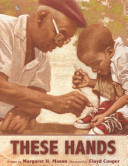
Joseph’s grandpa could do almost anything with his hands. He could play the piano, throw a curveball, and tie a triple bowline knot in three seconds flat. But in the 1950s and 60s, he could not bake bread at the Wonder Bread factory. Factory bosses said white people would not want to eat bread touched by the hands of the African Americans who worked there. In this powerful intergenerational story, Joseph learns that people joined their hands together to fight discrimination so that one day, their hands Joseph’s hands could do anything at all in this whole wide world.
- ISBN: 9780547215662
- Author: Mason, Margaret H.
- Illustrator: Cooper, Floyd
- Published: 2011 , Houghton Mifflin Harcourt
- Themes: 20th century, African American, Intergenerational relations, Prejudice and racism
- Descriptors: Early Years (ages 2-6), Historical Fiction, Picture Book, United States
- No. of pages: 32

Gives new meaning to the term ‘white bread’, doesn’t it? Wonder Bread is what my generation grew up eating. In fact there was a Wonder Bread factory in the neighborhood where I grew up and I remember the smell of bread baking as part of my childhood. So it is a shocker to be reminded of a time when such inequities existed. In addition to what Prisca and Marie had to say about this beautiful book, I think Floyd Cooper’s soft, soft palette is just perfect for this look back in time. Rather than being nostalgic, it is a warm look at family – and cultural – roots. Making this story an African American one, but truly an American story.
Prisca:
What a powerful book this is! It starts off very gently, a beautiful story of an African American grandfather sharing with his grandson the various things he’s done with his hands over his lifetime, such as play piano and throw a curveball. When the grandfather shifted to telling how his hands were not allowed to touch bread dough at the Wonder Bread factory because white people wouldn’t eat it, I was stunned and really taken aback. I loved how the next page explains how the grandfather joined hands with others to change that through petitions and protests, taking action in peaceful ways to push for change. It’s such an important story for all to know and the book makes it so accessible to young children.
Marie:
I also loved this book, Prisca. It was one of those “got me at the first read” books where I knew I wanted to share it with children and with my preservice students who will soon be teachers. I did some research on the book after first reading it and was captivated by the author’s recounting of how the book came to be from a story she was told by Joe Bennett, who had worked in the bakeries during the 1940s and 1950s. Mason recounts how so many stories from the pre-Cvil Rights Era we now know thanks to oral histories–the retelling of stories that are eventually written down for others to read and know. I agree that many of today’s readers are taken aback and shocked by the written and unwritten rules of what people of color were and were not allowed to do; which reminds me of how incredibly important it is that we all read these stories. Such a beautiful, touching, and critically important tale to share with young readers.